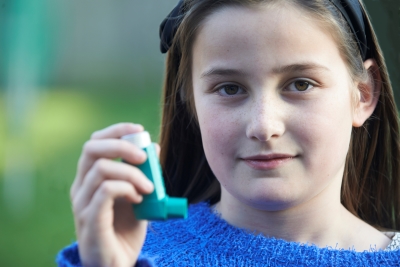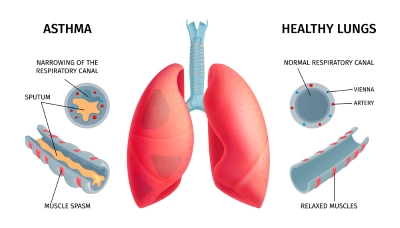Asthma Alert 2022 means that spring is just around the corner for us in beautiful Central Florida. FLASS is already putting asthma patients on alert!
Do you feel the warming trend in the air? Have you caught an indistinguishable but sweet floral scent on the breeze? It might seem trite to say, but springtime is already in the air. Additionally, so are some triggers for asthma sufferers.
Triggers: Spring Seasonal Allergens Begin Early This Year
As we have stated in previous blogs, all asthma sufferers experience their own unique pattern of triggers. This includes a lot of people who need to know their personal list.
The World Health Organization lists at least 235 million asthma sufferers. FLASS knows that each of them—and each one of you, out there– has an individualized set of asthma triggers.
Asthma Alert 2022: What Are Asthma Triggers?

Spring and Asthma Triggers Arrive! Get Your Inhaler Ready.
According to Mayo Clinic, asthma triggers are defined as “various irritants and substances that trigger allergies (allergens)…” Most importantly to note, they add that these triggers, “initiate the signs and symptoms of asthma…”
Allergy Alert 2022: A Signature Set of Triggers For Every Patient
The results of an encounter with a trigger are not pretty. Here are just a few:
- You have a sudden onset of coughing.
- Then, choking and wheezing ensue.
- Finally, after a rescue inhaler or other medication, these symptoms ease off.
Asthma Alert 2022: Back to Basics: The Common Triggers
FLASS warns all asthma patients that a classification of “triggers” can include very diversified irritants. Below are a few common ones:
- Smoke.
- Sudden changes in the air.
- Pollen.
- Dust.
- Insects and a million more irritants or allergies.
Any irritant or allergen can be an asthma trigger. Doctors and staff at Florida Lung, Asthma, and Sleep Specialists (FLASS) want you to understand the amazing individuality of asthma.
Imagine hundreds of triggers that might instigate a choking attack. Now, multiply them by mathematical combinations possible. Only then, can you imagine the challenges we see patients fighting every day.
The Key to Control: Know Your Triggers
FLASS often states that the key to controlling asthma is identifying a patient’s individual list of probable triggers. Then, of course, it is up to the asthma patient to lead a life that strives to avoid particular triggers.
Read on, and we will tell you more specifics in a moment. First, let’s establish a few basics by looking, step-by-step at the physical causes that instigate asthma attacks.
Allergy Alert 2022: After the Trigger, Comes the Attack!

This is the Awful Truth of Asthma. In Real Life, an Asthma Attack is Not Pretty. As the Airway Spasms and Swells, the Patient Gasps and Wheezes.
A summary of what happens when asthma is triggered goes beyond our usual understanding of a typical cough. Let’s look at it in some steps:
1. Inflamed Airways: Having the disease of Asthma generally means a patient has inflammation in the airways. “As you might imagine, inflammation causes the tissue of the airways to swell.
Then, it becomes acutely sensitive. This sets the stage for strong reactions to inhaled “substance.”
2. A Reaction In The Airways: Firstly, muscles tighten against airways. Then, the airways swell and hurt.
3. Sometimes the airway makes heavy, tacky mucus. Consequently, the airways become even more constricted. And therefore, the lungs get less airflow. Then, the patient begins to wheeze.
FLASS Asthma Alert 2022: Watch for These Signs and Symptoms
The Cough-Choke-Wheeze Syndrome: The circular reaction above results in asthma symptoms. We call these asthma attacks. Sometimes the reaction just goes away. Sometimes simply removing the irritant results in ceasing the symptoms.
Other times, only medication can stop the “chain reaction.” And the National Heart, Lung and Blood Institute warns, “Symptoms can happen each time the airways are inflamed.”
Causes of Asthma: A Separate Category From Triggers
Science tells us that two major factors cause asthma. Both genetics and environmental conditions advance the disease.
Have you ever noticed how “Asthma tends to run in families, suggesting an inherited component to the disease?” It seems to be true that “You’re more likely to have asthma if your parents have It.”
Here are a few of the “usual suspects” that can directly cause the “crime” of this disease:
1. Atopic Syndrome:
This simply means you have allergic hypersensitivity or atopic eczema and allergic rhinitis.
Likewise, respiratory infections during early childhood is another risk factor for asthma. Additionally, these infections can cause inflammation in the lungs and damage lung tissue. This affects lung function later in life.
2. Infant Viral Infections and Airborne Allergens or Irritants.
Secondly, infants or children who have early exposure to Viruses and Irritants deal with conditions before their immune system has matured. Therefore, they often risk developing asthma.
Only time and research will reveal the long-term effects of exposure to the coronavirus and variants and resulting asthmatic conditions. (We feel like there will be a future blog on that topic.
3. Before Birth Asthma Exposure:
The National Institute of Health also warns that a woman’s eating or smoking habits can cause her child to risk asthma later in life.
4. Allergic Asthma:
The science behind allergic asthma states that “the immune system reacts to harmless substances in the environment by releasing antibodies called immunoglobulin E.”
The problem doesn’t end there. “These antibodies cause certain immune system cells to release chemicals that produce inflammation in the lungs.”
The FLASS Asthma Alert 2022 Master-List of Common Triggers:
Just as we promised, below is a list of many of the typical triggers for asthma. Undoubtedly a few of them are familiar.
- Cockroaches, their shells, and their feces—(Ew.)
- Mold and Fungi, invisible instigators.
- Some foods and food additives.
- Household dust mites, the tiniest monsters behind your attack!
A Big FLASS Alert On Airborne Irritants
Here we almost need a “sub” list to bring you the roll call of guilty triggers that could instigate attacks. We have seen patients react to industrial emissions, vehicle exhaust, ozone.
Likewise in the same category, we have seen reactions to cigarette smoke, burning wood, burning grass, smog, or sulfur dioxide.
FLASS Asthma Alert 2022 for Fido and Fluffy
Pet dander (skin flakes from household animals) is a very common trigger. Additionally, we have to include their urine, feces, saliva, and, of course, their fur.
Asthma can also be induced by pollen, respiratory infections, and exercise.
Exercise-Induced Asthma

Do You Choke and Gasp For Air Every Spring? FLASS Can Help You Survive Asthma Nightmares.
According to Everyday Health. Com, “this condition was previously known as exercise-induced asthma…” Now it is termed Exercise-Induced Bronchoconstriction or EIB. Did you know that some people who do not have asthma, especially if they are in weak physical shape, can have EIB symptoms?
In the same context, the Asthma and Allergy Foundation of America reports that 90 percent of asthma patients suffer airflow difficulties and asthma symptoms in an exercise session?
The asthma experts here at FLASS have answers for you. And although it can’t be cured, asthma can be controlled.
After diagnosis, your FLASS asthma plan helps you with triggers, medication, treatment, and lifestyle instructions to help you maintain a healthy, happy life. Happy Spring!

